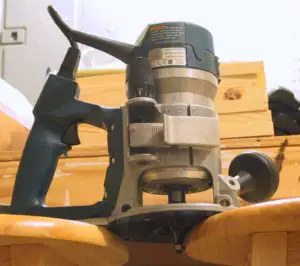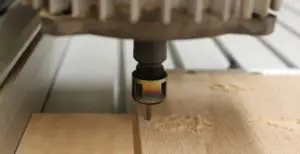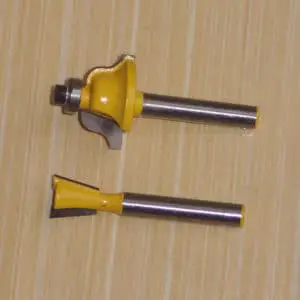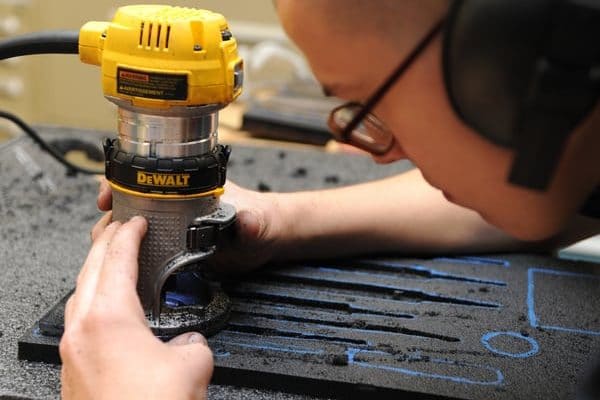For the novice and seasoned woodworker alike, routing is a skill that takes time and patience to ultimately get the results you seek on a consistent basis. One of the key aspects of this skill often overlooked is that of router speed. In this guide, we will examine the symptoms woodworkers encounter due to router speed problems and will seek to help you remedy the issues you may be facing. Alternatively, if you aren’t experiencing problems currently, perhaps your result can be made even better. Let’s take a look.
Why Does This Matter?
Let’s see if this sounds familiar… You unbox your nice, shiny new router, attach a bit, grab a scrap piece of wood and let ‘er rip to see “how it goes.” Before you did so, you likely had no idea what the speed your router was running at or even why that may be relevant.
The first, most important aspect to note about router speed is not often the first inclination of the woodworker: damage to the bit or the router itself. Indeed, a simple mistake can cause said shiny, new router to become a wonderful paperweight in the first use of the tool. If nothing else, please know this is a profoundly possible reality if you’re not careful. Further, that scrap piece of wood you chose may or may not have been appropriate for the bit you used, or the speed the router is set to. Believe it or not, this too can break your woodworker heart in minute one of your routing life. So without further ado, let’s examine common problems woodworkers face with router speed.
Signs your bit speed is too fast
Let’s say that you got lucky for the sake of argument and you have used your new router to do cut a piece of wood. If you closely examine that that piece of wood, you may be surprised at the result.
If you look at the edges of the cut—the places where the bit made contact with the wood—you may see a host of different things that the wood is telling you. The first, most common symptom you’ll notice is burn marks on the wood. This will be seen anywhere the bit contacted the wood and can present more significantly if the cut was made with uneven pressure or feed rate throughout the cut.
The appearance of skip marks are another clue that your bit was rotating too quickly—or a sign that you didn’t apply enough pressure while routing. You might also see places along the cut where the bit actually bounced off of the wood. This motion will have left areas of the cut line untouched.
The corollary opposite of the former symptom is damage made to the wood. In fact, you may see gauges or chunks of wood that have been torn from the surface of the cut line where the bouncing router bit did a bit more than it should have.

This is especially prevalent when routing end grain—a router bit spinning too quickly can grab onto areas of the wood that are soft, fibrous or inconsistent with the rest of the surface you are routing. End grain, where both the fibers of the wood and accents of wood grain are exposed, present the worst combination of conditions a woodworker will face for a routing project. Compromising this significantly further is a router speed that is too fast for the bit or the wood being routed. You can very easily ruin a project by not properly adjusting router speed when addressing end grain.
Each of the items in the “too fast” column will also have an effect on your router bit’s lifespan. If your router speed is too high when used on a piece of wood, the bit could dull much more quickly than it should simply because it will overheat. Heat is the enemy of router bits!
Please bear in mind: every router bit has a router speed range recommendation that will vary based on the size and type of the router bit, and the intended router type (handheld versus table). However, your router may or may not fit into the parameters issued by the router bit manufacturer. In fact, your router itself may cause one or more of the above outcomes simply due to how it moves and reacts to the router bit. It’s important to always pay attention to you settings and make adjustments accordingly.
There is a test you can run that will help you establish the fastest speed you should use for a particular router bit. Try this, and you will be able to properly identify the upper speed boundary your router can be used for a given router bit:
- Ensure the router bit is properly installed
- Set your router to the lowest possible speed and turn it on. Observe the behavior of the router, including the sound and the way your router vibrates with the bit spinning
- Once you are comfortable with what you are observing, turn off your router and increase the speed slightly. (Never increase the speed beyond the router bit manufacturer’s recommendation)
- Repeat the test, watching for changes around how the router behaves. Namely, you may notice the router vibrating more violently than it does at lower speeds or making either a buzzing or a grinding sound. If you observe either behavior and are within the speed boundary set by the router bit manufacturer, you have ascertained you are beyond the uppermost speed boundary for your router, for that bit
- Repeat the test in the opposite direction, gradually reducing your router speed until you no longer observe excessive vibration or noise.
- Note this speed as the highest your router will properly function with that router bit
Please understand that though you have determined the topmost speed your router will function with that particular bit, it does not mean you have fully determined the speed to use for your project. There are still several other factors to explore before this decision can be made.
Before we get there, let’s examine what happens if your bit runs too slowly.
Signs your bit speed is too slow
If your router speed is too slow, this can also cause problems. The most common issue you’ll face is a choppy finish on the surface of the wood. This is a similar symptom to your router speed being too fast, albeit without the burning or additional damage made to the wood. In short, the bit is moving too slowly relative to the density of the wood and cannot make cuts fast or deep enough throughout the cut. So, if you see an uneven cut—usually presented in the form of waves on the wood’s surface—your router speed is very likely too slow.
Ultimately, this too can dull your router bit prematurely because the bit itself could overheat—just like the “too fast” symptom. Please bear in mind that there are still a number of factors that govern whether your router speed is too slow or too fast.
It should be mentioned that a dull bit can have a similar effect on a piece of wood as both the “too fast” and “too slow” symptoms. You may need to sharpen or replace your router bit if:
- It is difficult to move your router through wood, especially softwood
- Burned or choppy (or both) surfaces are observed and router speed is known to be within an acceptable boundary bearing all factors.
One of the key factors in play for any routing project is the wood you are routing, and this is what we will explore next.
Speed by type of wood
Before we get too deep here, relative to our purposes of routing, let’s educate ourselves about wood. In particular, understand hardwoods and softwoods are defined as such not by their density, but rather by the way their seeds are propagated. Hardwoods are those that are angiosperms, or those that form from enclosed seeds (acorns, apples, etc.) Softwoods are those that are gymnosperms, or those that form from uncovered sees (cones). It is not a hard and fast rule that all hardwoods are denser than softwoods.
Wood density—measured most commonly using the Janka hardness test on each wood species—and the presence of moist sap or resin are the key governing factors when considering router speed. Though it is not possible to accurately say with confidence that every piece of a particular wood type will route perfectly with a set speed range, there are generalizations that should get you close. Based on what you see, you can perfect the router speed you are using, watching for the behaviors we have already explored.

Factually, you may have a piece of maple that behaves more like a piece of pine and vice versa. Regardless, most hardwoods will require a higher routing speed for a soft finish. You are more susceptible to the behaviors we’ve discussed in the “too slow” category when routing dense hardwood. You may observe a choppy or uneven surface on the face of your cut. If so, consider using a speed closer to your documented upper limit for the router bit you are using and try the pass again. You should observe a different result with the higher speed.
Let’s talk heartwood versus sapwood with a dash of moist organic compound, okay? Reducing the ridiculousness, each item should be considered when something spinning at a rapid rate (like a router bit…) encounters them. Each will behave differently in a routing project, and more specifically, will affect the router speed you employ.
Every tree has a sap ring and sapwood. In fact, all wood at one time is sapwood. As a tree grows, less wood is needed for nutrient distribution and the sapwood becomes heartwood. This set of cells serves a different set of functions, from warding off insects to the overall stability of the tree.
Most retailers will sell heartwood, which in most cases has a reduced amount of moisture in the wood, simply due to its function in the trunk of the tree. However, some species of wood—maple and cherry as two good examples—retain a notable amount of moisture, even when milled. Maple’s sapwood can extend for several inches. It’s not uncommon, as a result, for some sapwood to be present in milled maple stores.
Sapwood and any heartwood that has a high level of moisture will tend to burn when cut or routed. It is highly recommended that reduced routing speeds are used on these planks, regardless of the density of the wood. In these circumstances, lighter, progressive cuts with reduced routing speeds are much preferred to full edge cuts. Feed rates are also a key consideration bearing all other factors. We will discuss feed rates in much more detail as we get closer to our conclusion.
For now, let’s consider how a router bit’s construction can affect how you use it.
Speed variance by most common bit types
Router bits are made of two primary materials: Carbide and High Speed Steel. We can go one step further and introduce two subcategories to the Carbide side of the equation: Carbide Tipped and Solid Carbide router bits. Each are readily found, and each have distinct uses you should be familiar with.
 High Speed Steel is the cheapest material and it’s also the most prone to quick dulling. If you opt for a High Speed Steel router bit, your wood should be a (truly) soft softwood. You will need to avoid overheating the bit at all costs. So, any High Speed Steel router bit should be used at the lowest speed possible to get a soft finish. High Speed Steel router bits are not your best option, especially if you have a large project requiring the same routing throughout. Opt for High Speed Steel in targeted, limited projects. Obviously, the shape of the bit that you need will depend on the type of cut you need, but this is a good set that I’ve used before that’s a nice balance between cost and quality if you are needing a pack of end mill bits. This set would be good for someone starting out with a router just to get a feel for how the machine works.
High Speed Steel is the cheapest material and it’s also the most prone to quick dulling. If you opt for a High Speed Steel router bit, your wood should be a (truly) soft softwood. You will need to avoid overheating the bit at all costs. So, any High Speed Steel router bit should be used at the lowest speed possible to get a soft finish. High Speed Steel router bits are not your best option, especially if you have a large project requiring the same routing throughout. Opt for High Speed Steel in targeted, limited projects. Obviously, the shape of the bit that you need will depend on the type of cut you need, but this is a good set that I’ve used before that’s a nice balance between cost and quality if you are needing a pack of end mill bits. This set would be good for someone starting out with a router just to get a feel for how the machine works.
Carbide Tipped router bits are much more durable than High Speed Steel. They are therefore appropriate for use in both softwood and hardwood and are less likely to dull prematurely if router speed is used as prescribed in this guide. Bosch makes nice consumer level bits. This is a nice set they offer if you are looking for a variety of bits from them.
Solid Carbide router bits are always the most expensive router bits and are used for very specific routing projects. Mortising, laminate trimming or pattern cutting are the most frequent uses for Solid Carbide router bits. Again, attention to routing speed will be paramount to the success of your project. My go to brands for this type of bit is those made by Freud, Whiteside and CMT. They all make good quality parts. Between the three of them, you should be able to find a bit that will work for your need. Here’s a link to the wide assortment of bits that these three companies make.
One further distinction affecting all types of router bits is the size of the shank. Both ½” and ¼” options are available. Here too, your routing project will determine the appropriateness of either size. ¼” shanks will work perfectly in softwood using slower router speeds. If you are using hardwoods requiring higher router speeds, opt for ½” shanks every time to reduce the risk of breakage.
Putting it all together
Undoubtedly, you have reached this point and likely wondered, “For a router speed guide, no speeds have been presented.” This has been intentional. You see, to this point, we have talked generally about the outcome of router speed according to a host of unique criteria.
The absolute truth is that a reference table that states certain blades should always be set to a specific range of speeds can set you up for failure.
Your router will have a minimum and a maximum speed. The router bits you use will have a minimum and a maximum speed recommendation. The best possible router speed, considering your router and the router bit you use on the specific piece(s) of wood in your routing project almost assuredly do not fit into a generalized chart.
In this guide, we have presented a host of testing criteria to help you determine the optimal router speed for your project. We strongly recommend you arrive at your best router speed instead of arbitrarily determining it with a chart. Considering all appropriate factors will give you the best possible outcome.
Extending this discussion to feed rate seems appropriate at this time, not just because it was alluded to earlier in the article, but rather it’s the right thing to do. You see, your router speed can be perfect for your routing project, but your feed rate (the speed you cut the wood using the router) can introduce another factor worth considering.
Invariably, the notion of feed rate is tightly coupled with the router bit’s chip load rate, or the rate each part of the router bit removes wood, measured in millimeters per second. You see, every router bit manufacturer has a recommended feed rate, measured against router speed. This is yet another angle worth considering when executing your routing project. It will vary by manufacturer, so please ensure you are familiar with the router bit manufacturer’s recommendations.
We wish you the best as you navigate the world of router speeds. Thanks for your time!




